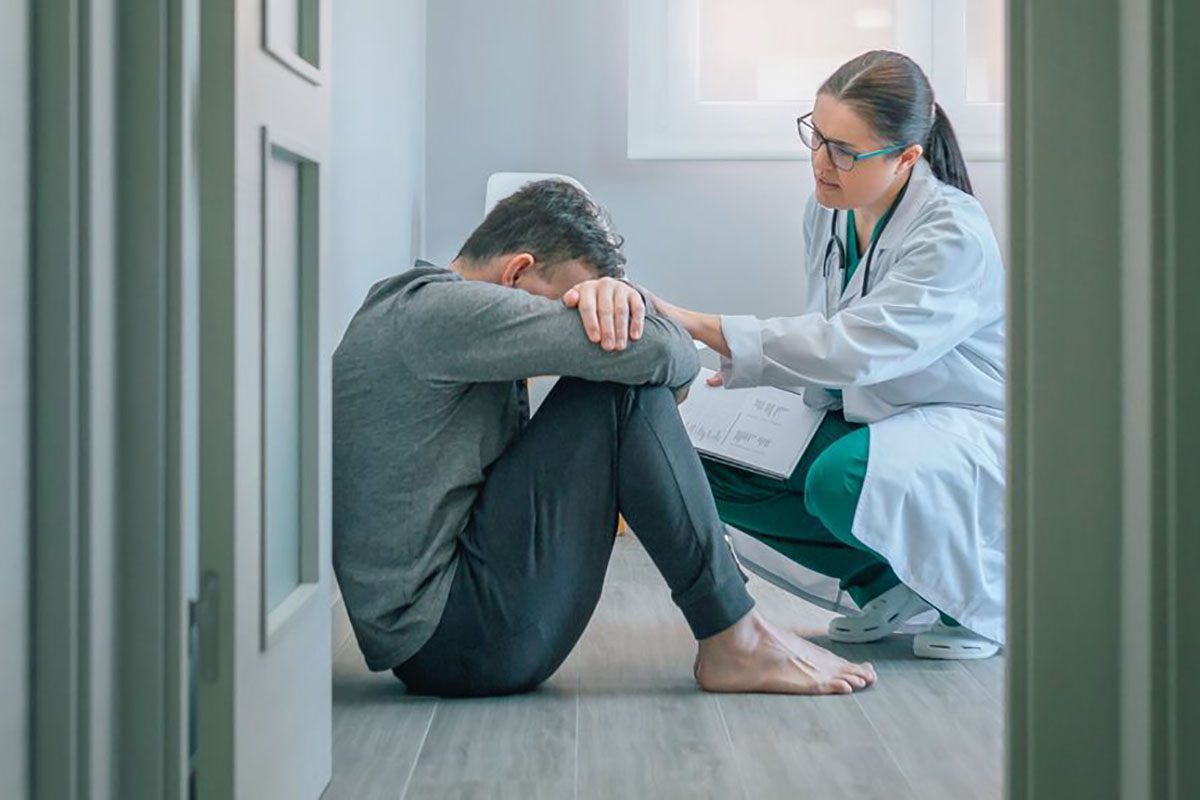
J Clin Psychiatry 2022;83(2):21com14268
To cite: Grossman DH, Hendricks PS. Shedding light on classic psychedelics and self-harm. J Clin Psychiatry. 2022;83(2):21com14268.
To share: https://doi.org/10.4088/JCP.21com14268
© Copyright 2022 Physicians Postgraduate Press, Inc.
aDepartment of Health Behavior, School of Public Health, University of Alabama at Birmingham, Birmingham, Alabama
*Corresponding author: Peter S. Hendricks, PhD,1665 University Blvd, Birmingham, AL 35233 ([email protected]).
See article by Zeifman et alZeifman et al
As research on classic psychedelic–assisted treatments continues to expand, we can expect that findings will sometimes challenge or elucidate long-held conventional beliefs about the purported dangers of these substances. One such notion has been that they precipitate suicidality1 and other self-harm behaviors (eg, jumping off of buildings believing one can fly, walking in front of traffic2) in some users. While indeed such cases exist (eg, McFadden3), the meta-analysis of classic psychedelic therapy and suicidality by Zeifman et al4 is one of several recent publications offering compelling evidence to the contrary. The study, which analyzed suicidality data from 7 classic psychedelic therapy trials and found acute and sustained decreases on all relevant measures, warrants optimism for the treatment of suicidality.
Like many negative perceptions of classic psychedelic use, it is likely that the notion of increased risk of suicide and self-harm first appeared in the late 1960s, when “the dark side of psychedelics” (Pollan5[p10]) began to receive widespread attention from researchers and journalists alike. For example, amid the pervasive moral panic of this period, there was the high-profile suicide in 1969 of Diane Linkletter, the 20-year-old daughter of television personality Art Linkletter, who jumped to her death from her sixth-floor apartment window in West Hollywood. Her father claimed that she was under the influence of lysergic acid diethylamide (LSD) at the time of her death.6 Although the role of LSD was never actually confirmed, Art Linkletter began a lifelong crusade against the dangers of illicit drugs, framing his daughter’s death as a cautionary tale of the tragic effects of drug use on the American family. He appeared on talk shows, wrote for news outlets, and eventually became a drug policy advisor to President Richard Nixon.7,8
Similarly, though army biologist Frank Olson’s suicide occurred in 1953, it was in 1975 that the Central Intelligence Agency (CIA) revealed that Olson was surreptitiously dosed with LSD by his colleague Sidney Gottlieb, head of the CIA’s clandestine MK-Ultra program, just 9 days prior to his death.9 The circumstances surrounding Olson’s death and whether it was truly a suicide remain mysterious, even becoming the subject of Errol Morris’s Netflix documentary Wormwood. Nonetheless, yet another potential classic psychedelic–induced suicide had made its way into the headlines.
Cases like Linkletter’s and Olson’s loomed large in the public perception of classic psychedelics, despite the empirical research at the time only tenuously connecting classic psychedelics with rare instances of increased suicide risk. One prominent example was a survey study by Sidney Cohen,10 which queried dozens of researchers about the adverse reactions they observed while conducting experimental treatments with LSD on individuals with various psychiatric illnesses. The study reported a small handful of attempted or completed suicides during or after ingestion of LSD, although it was noted that these were all patients who responded poorly to treatment. Indeed, data from this study and others indicated that, while suicides or attempted suicides did occur, they were infrequent and the role that classic psychedelics played in them was often ambiguous.11–13
Over the last several years, a new wave of research has emerged investigating the association between suicidality and both naturalistic and therapeutic use of classic psychedelics. Similar to Cohen’s10 reports, instances of classic psychedelic–related suicidality continue to be rare, but recent findings invite a more nuanced understanding. For example, Carbonaro and colleagues’ survey14 of 1,993 participants’ most challenging psilocybin experiences found 5 instances of increased suicidality, 3 of which involved suicide attempts. Conversely, this same study found 6 reported instances of complete remission of suicidal ideation attributable to the psilocybin experience in previously suicidal individuals. At the population level, lifetime classic psychedelic use was found to be associated with a decreased risk of suicidal thoughts, planning, and attempts.15 Returning to the meta-analysis of Zeifman et al,4 large acute and sustained decreases were found on measures of suicidality during and after classic psychedelic therapy, though the authors note that most of the studies reviewed excluded severely suicidal individuals. Small increases in suicidality during the acute phase were noted for a minority of participants (6.5%), though these were transient and resolved in all cases.
Bringing these findings together, classic psychedelic therapy for suicidality appears to be a promising avenue for further investigation. Despite this, the research and anecdotes about increased suicidality and other self-harm attributed to psychedelics, though evidently rare, remain a critical concern for this work to address. It is not known what factors might moderate if a suicidal individual benefits from a classic psychedelic treatment, or if it might lead to worsening symptoms. One future direction could be to query classic psychedelic users who experienced a reduction or resolution of suicidal symptoms and compare them against those whose symptoms were exacerbated to try to elicit potential moderators. Additionally, it is possible that suicidal ideation may worsen temporarily for some individuals in this treatment before it gets better, as it did slightly and briefly in a minority of participants reported by Zeifman et al.4 It is also unclear whether these increases might have snowballed in a suboptimal non-supportive setting and to what extent the therapeutic support offered protection against this adverse outcome. However, as in the case of exposure therapy,16 it is also possible that this temporary worsening reflects a habituation toward distressing emotional material otherwise avoided and therefore may be a crucial step toward wellness. Finally, given the relatively small sample size in Zeifman and colleagues’ meta-analysis,4 suicide-related adverse events may increase in prevalence as classic psychedelic treatments become mainstream. Since context is thought to be central to shaping the classic psychedelic experience,17 careful attention must be paid to the setting and therapeutic process to minimize this likelihood.
Looking at the evolving trend of classic psychedelic research in the 21st century, there is a great deal about which to be optimistic. Zeifman and colleagues’ meta-analysis4 poses yet another bright possibility for classic psychedelic therapy in the treatment of suicidality. However, it remains important that we are not quick to dismiss sensationalized accounts of self-harm as nothing but myth. Though rare, there remain risks that require careful consideration. It is our hope that future research clarifies who is most subject to these risks, what factors best identify them, and how best to navigate their treatment safely.
Published online: January 18, 2022.
Potential conflicts of interest: Dr Hendricks is on the scientific advisory boards of Bright Minds Biosciences Ltd, Eleusis Benefit Corporation, and Reset Pharmaceuticals Inc. Mr Grossman has no conflicts of interest.
Funding/support: None.
References (17)

- Fadiman J. The Psychedelic Explorer’s Guide: Safe, Therapeutic, and Sacred Journeys. Simon and Schuster; 2011.
- Henderson LA, Glass WJ. LSD: Still with Us after All These Years. ERIC; 1994.
- McFadden R. “Flying” on LSD, Student Plunges to Death in Greenwich Village. The New York Times. 1969:25.
- Zeifman RJ, Yu D, Singhal N, et al. Decreases in suicidality following psychedelic therapy: a meta-analysis of individual patient data across clinical trials. J Clin Psychiatry. 2022;83(0):21r14057.
- Pollan M. How to Change Your Mind: What the New Science of Psychedelics Teaches Us about Consciousness, Dying, Addiction, Depression, and Transcendence. Penguin Books; 2019.
- Linkletter Says Daughter Took LSD Before Death. The New York Times. 1969:50.
- Grimes W. Art Linkletter, TV Host, Dies at 97. The New York Times website. https://www.nytimes.com/2010/05/27/arts/27linkletter.html?searchResultPosition=3. Published 2010. Accessed September 17, 2021
- Johnson T. Art Linkletter’s War on Drugs. Variety. Published 2010. https://variety.com/2010/biz/opinion/art-linkletters-war-on-drugs-39200/
- Mooar B. Tests Contradict U.S. Story Of Man’s Suicide. Washington Post website. https://www.washingtonpost.com/archive/local/1994/07/12/tests-contradict-us-story-of-mans-suicide/17be5717-77ca-41d5-9f50-359234dae5bc/. Published 1994. Accessed September 17, 2021.
- Cohen S. Lysergic acid diethylamide: side effects and complications. J Nerv Ment Dis. 1960;130(1):30–40. PubMed CrossRef
- Van Dusen W, Metzner R. The long-term effects of psychedelics. Clin Toxicol. 1968;1(2):227–234. CrossRef
- Smart RG, Bateman K. Unfavourable reactions to LSD: a review and analysis of the available case reports. Can Med Assoc J. 1967;97(20):1214–1221. PubMed
- Strassman RJ. Adverse reactions to psychedelic drugs. a review of the literature. J Nerv Ment Dis. 1984;172(10):577–595. PubMed CrossRef
- Carbonaro TM, Bradstreet MP, Barrett FS, et al. Survey study of challenging experiences after ingesting psilocybin mushrooms: Acute and enduring positive and negative consequences. J Psychopharmacol. 2016;30(12):1268–1278. PubMed CrossRef
- Hendricks PS, Thorne CB, Clark CB, et al. Classic psychedelic use is associated with reduced psychological distress and suicidality in the United States adult population. J Psychopharmacol. 2015;29(3):280–288. PubMed CrossRef
- Foa EB, Kozak MJ. Emotional processing of fear: exposure to corrective information. Psychol Bull. 1986;99(1):20–35. PubMed CrossRef
- Carhart-Harris RL, Roseman L, Haijen E, et al. Psychedelics and the essential importance of context. J Psychopharmacol. 2018;32(7):725–731. PubMed CrossRef
This PDF is free for all visitors!




